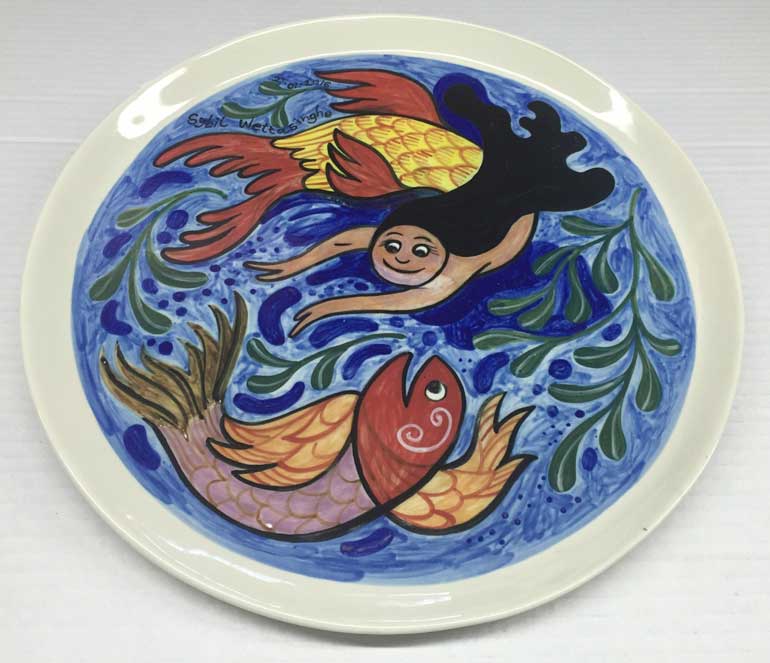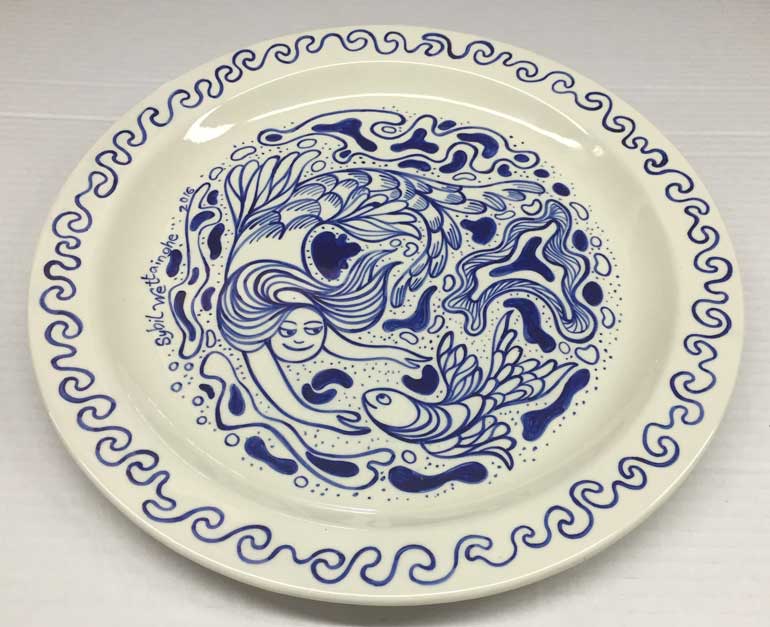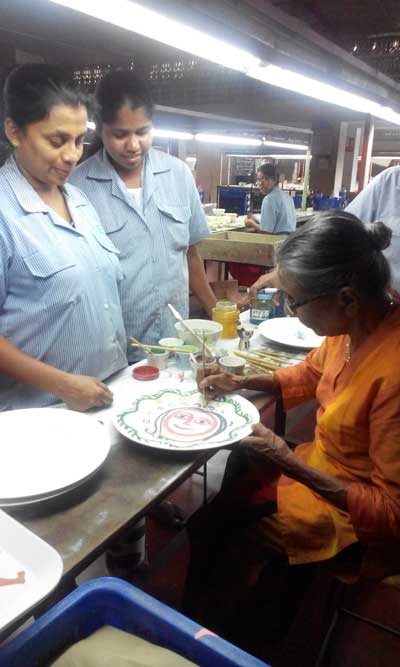Saturday Dec 14, 2024
Saturday Dec 14, 2024
Saturday, 9 April 2016 00:00 - - {{hitsCtrl.values.hits}}






 By D.C. Ranatunga
By D.C. Ranatunga
The delightful story of the umbrella thief – ‘Kuda Hora’ – is in the news again. Really ‘Kuda Hora’ has been talked about for the past  60 years. It continues to be the talk of the town. It brought Sybil – Sybil Nanda to most and Aththamma to others – into the limelight six decades ago. Today she is possibly better known around the world than in her own country.
60 years. It continues to be the talk of the town. It brought Sybil – Sybil Nanda to most and Aththamma to others – into the limelight six decades ago. Today she is possibly better known around the world than in her own country.
Hearing about a novel presentation of ‘Kuda Hora’ in ceramic to commemorate its 60th anniversary this weekend (at J.D.A. Perera Gallery at Horton Place), I started hunting for more details.
The unique personality she is, Sybil will launch her own hand-painted range of ceramics at the exhibition which will feature a limited edition ceramics range on refined stoneware pieces of the ‘Kuda Hora’ story made by Midaya Ceramic Company. A customised limited edition umbrella range depicting images from ‘Kuda Hora’ created by Rainco will also be displayed.
Making a personal invitation, Sybil says: “The world renowned ‘Kuda Hora’ is 60! Come join me in this worthy celebration! You will see ‘Kuda Hora’ in a magical garb.”
This is yet another ‘one up’ in Sybil’s cherished career. Just like the writer, Kuda Hora too has had an unforgettable journey. First translated into Japanese and winning its first award at the Bologna Book Fair, it is being used in at least 13 countries including Norway, Sweden, Denmark the United States, China, Korea and South Africa – a unique achievement for a book written in Sinhala.
The Japanese seem to be having a ‘soft corner’ for ‘Kuda Hora’. In 1986, it won the Best Children’s Foreign Book Award in Japan when the award was first introduced. The following year, the children of Japan chose ‘Kuda Hora’ as the most popular story in a competition organised by the Library Association of Japan.
In fact, even the idea of ‘Kuda Hora’ in ceramic has been made by a Japanese professor who had seen her recently. He had indicated there is bound to be a demand in Japan and other countries for such novel designs.
Celebrity
Now in her late eighties, Sybil is a celebrity. Her one-time contemporary at Lake House, Sumana Saparamadu refers to her as “a celebrity not only at home, the icon of children’s literature in Sinhala, and acclaimed abroad as a master story teller and illustrator of stories for children,” in the preface to Sybil’s biography ‘The Story of Sybil Wettasinghe’.
Midaya Ceramics Managing Director Anura Warnakulasuriya feels Sybil has not got enough recognition in Sri Lanka compared to the international exposure she has received. “We believe that Mrs. Wettasinghe should be a more common household name in Sri Lanka but unfortunately she is better known in other countries,” he says. “We want to change this and give her the recognition she deserves.”
He is confident the exhibition will be a big boost for her contribution towards improving children’s literary levels. “It’s really a family event. Admission is free and there will be activities for everyone to enjoy. There will be live performances with the accent on theatre and puppetry,” he says. The performances are dramatised narrations of Sybil’s most popular stories. The exhibition ends tomorrow.
Recognition
Over the years Sybil has been the recipient of many an award. They were all in recognition of her artistic and literary talent except one. That was the Nikkei Asia Prize in recognition of her “magnificent contribution to enrich people’s lives in the region”.
“Her works, which draw upon Sri Lanka’s cultural diversity and natural beauty, have been translated into numerous languages and are loved by children around the world” was how she was introduced at the award presentation in Tokyo in 2012.Identified as “a Sri Lankan writer and illustrator of children’s books”, she was the first Sri Lankan to be presented with this award. Three winners are selected from three categories from among Asians every year.
In her acceptance speech, Sybil said: “I am an octogenarian, who is a child at heart. I have five grandchildren of my own. I consider all the world’s children as my own. I love them all. Children are the spice of my life.”
The Prize has been created and sponsored by Nikkei Inc., the publisher of Japan’s leading newspaper in the field of business, economy and culture.
Career
Starting her career as an artist in the ‘Lankadeepa’ in the late 1940s, she moved over to Lake House in the early 1950s, soon became a book illustrator and then a children’s story-teller (writer) teaming up with Royal Junior’s Headmaster H.D. Sugathapala (creator of ‘Navamaga’ – additional reader for grade V students), pioneered the batik industry creating unusual designs, edited the children’s weekly ‘Bindu’ for Upali Newspapers and settled down to illustrating and writing books for children.
Sybil is in much demand all the time. She gets invited to relate stories at children’s gatherings, organise art competitions among children, serve on panels to select artistic work, and deliver talks related to writing. I closely observed her commitment as the ‘Safety Ambassador’ of CTC Eagle Insurance in its campaign to promote safety among children.
She wrote and illustrated two books ‘Mallitai Matai’ and ‘Punchilamai Rattaran’ and conducted drama festivals to instil the safety message in the minds of children. She addressed seminars for pre-school teachers to convince them of the importance of promoting safety among young ones. Being bilingual, Sybil had the added advantage of writing in both Sinhala and English. She translated selected books which soon popular among the adults too. ‘The Child in Me’ (Gratiaen Prize winner 1996) and ‘Eternally Yours’ relating her childhood days were two such hits. ‘The Giddi Aunt’ (2012) was her first collection of short stories in English.
As Sybil sums up her long career in her biography, her life has been “a long beautiful dream, a medley of fantasies and realities and enchantingly magical wonders…so seems to me.”